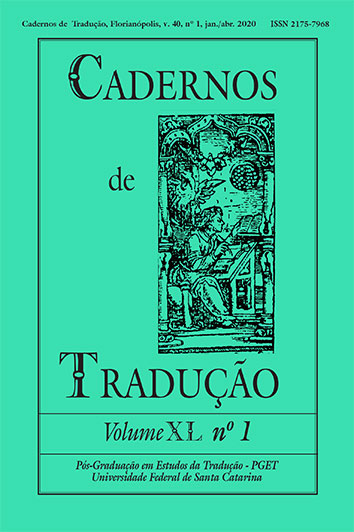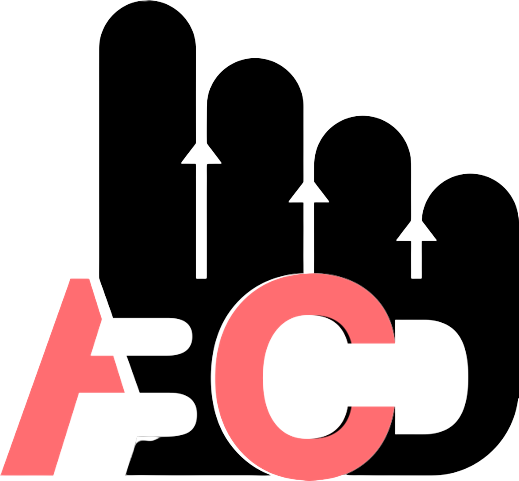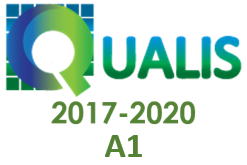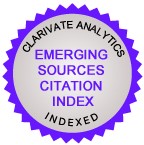Translating the Violent Content of Grimm Brothers’ Fairy Tales: An Eye-Tracker Experiment
DOI:
https://doi.org/10.5007/2175-7968.2020v40n1p17Abstract
Eye tracking has been introduced as a tool to analyze cognitive processes of translators in recent years. Current research with eye tracker focuses on examining translation processes. As far as we know, however, this tool has not been used for detecting eye movement behaviors related to the cognitive processing of violent content in the source text (ST). As research in this area is emerging, this study aims to determine if semantic associations with violent actions or activities in the ST produces a response in the gaze behavior of the translator. This paper presents an experimental study to investigate the cognitive processes involved in the translation of three condensed versions of Grimm brothers’ fairy tales. The selected texts present the range of violent content for which these tales are renowned, from more modern adaptations which remove the violent content to very explicit and graphicly violent stories. Texts were translated from Spanish (L2) into English (L1). Fixation counts and fixation duration were calculated for each participant in ten Areas of Interest (AOI) which represented challenges in translating various aspects of grammar and violence presented in these tales.References
Carandini, M. “Visual cortex: Fatigue and adaptation”. Current Biology, [s.l], 10.16 (2000): 605-607.
Ferreira, A. Direcionalidade em tradução: uma investigação do processamento cognitivo de tradutores profissionais em tradução direta e inversa no par linguístico inglês-português. Dissertação (Mestrado em Linguística Aplicada) – Faculdade de Letras, Universidade Federal de Minas Gerais, Belo Horizonte, 2010(a).
Ferreira, A. “Analyzing recursiveness patterns and retrospective protocols of professional translators in L1 and L2 translation tasks.”. The Development of Professional Competence Translation and Interpreting Studies. The Journal of the American Translation and Interpreting Studies Association Translation and Interpreting Studies. [s.l], 9.1 (2014(b)): 109-127.
Ferreira, A., Schwieter, J. W., Gottardo, A., and JONES, J. “Cognitive effort in direct and inverse translation performance: Insight from eye-tracking technology.” Cadernos de tradução, Florianópolis, 36, 3 (2016(c)): 60-80.
Grimm, J. H. (n.d.). “La Cenicienta Cuento”. Retrieved from https://www.grimmstories.com/es/grimm_cuentos/la_cenicienta.
Grimm, J. H. (n.d.). “The Three Snake Leaves”. Retrieved from https://www.grimmstories.com/language.php?grimm=016&l=en&r=es.
Grimm, J. H. (n.d.). “The Robber Bridegroom”. Retrieved from https://www.grimmstories.com/language.php?grimm=040&l=en&r=es.
Hunziker-Heeb, A. “The problem-solving processes of experienced and non-experienced translators”. In: KERSTEN, Saskia; LUDWIG, Christian; MEER, Dorothee; RÜSCHOFF, Bernd. Papers selected from the Junior Research Meeting. Language learning and language use - applied linguistics approaches. Duisburg: UVRR (2012): 177-186.
Hvelplund, K. T. “Eye Tracking in Translation Process Research. The Handbook of Translation and Cognition”, edited by John W. Schwieter and Aline Ferreira, Wiley Blackwell Press, 2017: 548-264.
Jakobsen, A. L. “Effects of think aloud on translation speed, revision, and segmentation”. Triangulating Translation. Perspectives in Process Oriented Research, edited by Fabio Alves, (2003): 69-95. Amsterdam: John Benjamins, (a)
Jakobsen, A. L. “Investigating expert translators’ processing knowledge”. Knowledge Systems and Translation (2005):173-189. doi:10.1515/9783110924305.173.(b)
Katan, D. “Translation Theory and Professional Practice: A Global Survey of the Great Divide”. HERMES - Journal of Language and Communication in Business, [s.l], 22.42 (2017): 111-153.
Korpal, P. “Eye-tracking in Translation and Interpreting Studies: The growing popularity and methodological problems” (2015). https://www.researchgate.net/publication/297484787_Eye-tracking_in_Translation_and_Interpreting_Studies_The_growing_popularity_and_methodological_problems.
PTSD: National Center for PTSD. (2018, September 24). Retrieved from https://www.ptsd.va.gov/professional/assessment/adult-sr/ptsd-checklist.asp.
Sandel, T. “Rich Points”. The International Encyclopedia of Language and Social Interaction, edited by Karen Tracy, Cornelia Ilie, and Todd Sandel . (2015).Wiley-Blackwell: Malden, MA.
Swender, E., Martin, C.;, Rivera-Martinez, M., Kagan, O. E. “Exploring Oral Proficiency Profiles of Heritage Speakers of Russian and Spanish”. Foreign Language Annals, [s.l], 47.3 (2014): 423-446.
Tirkkonen-Condit, S. “Think-Aloud Protocols”. BROWN, Keith. Encyclopedia of Language & Linguistics. 1 (2006): 678-86.
Zipes, J. “How the Grimm Brothers Saved the Fairy Tale”. (2015). Retrieved February 23, 2019 from https://www.neh.gov/humanities/2015/marchapril/feature/how-the-grimm-Brothers-saved-the-fairy-tale.
Downloads
Published
How to Cite
Issue
Section
License
Copyright (c) 2020 Cadernos de Tradução

This work is licensed under a Creative Commons Attribution 4.0 International License.
Copyright Notice
Authors hold the copyright and grant the journal the right for their articles' first publication, being their works simultaneously licensed under the Creative Commons Attribution License (CC BY), which allows the sharing of such works with its authorship acknowledged and its initial publication in this journal.
Authors are allowed to enter into separate additional contractual arrangements for the non-exclusive distribution of the journal's published version of the work (e.g., post it to an institutional repository or as a book chapter, with an acknowledgment of its initial publication in this journal).






















































